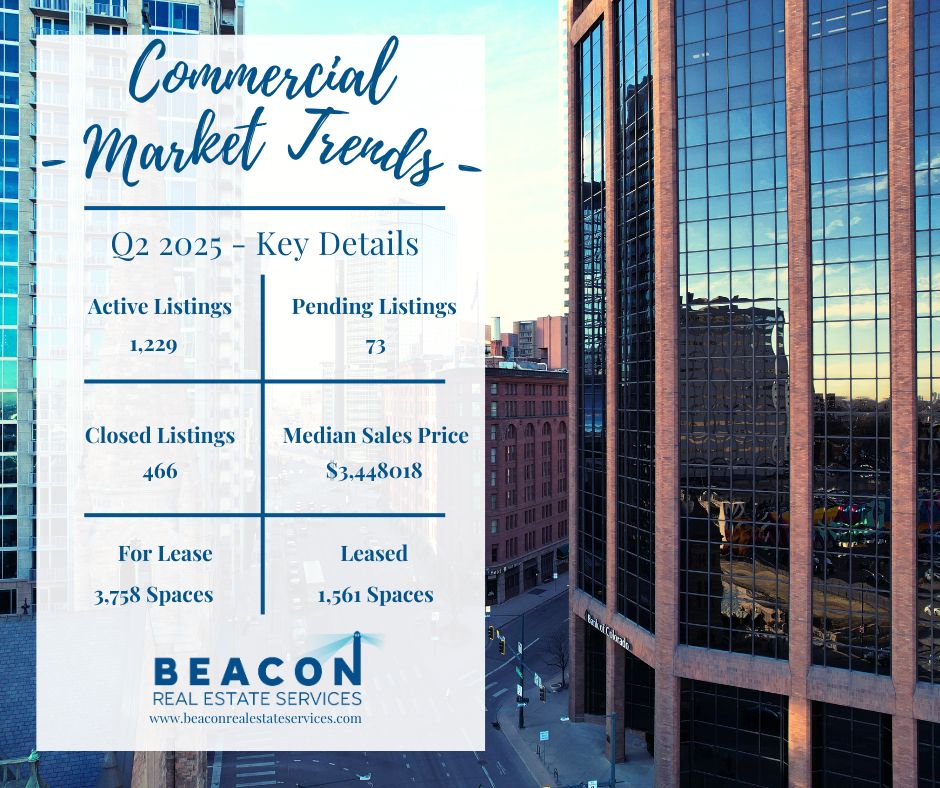
The Denver Commercial Real Estate Market saw some interesting trends emerge in Q2 2025. The four major property types saw $1.6B in total sales for Q2, which is $300M more than Q2 2024. This represents a large increase in sales volume. Office sales are still the lowest transaction volume property type. Although many companies are bringing employees back to the office, demand for the properties Denver has remains subdued.
The four commercial property types we are tracking are: retail, multi-family, office, and industrial. It is interesting to look at the Commercial Real Estate Market as a whole and at these individual property types. Let’s dive into supply, demand, new construction, vacancy rates, and rent growth for Denver Commercial Real Estate.
Below is a summary of key details for each property type.
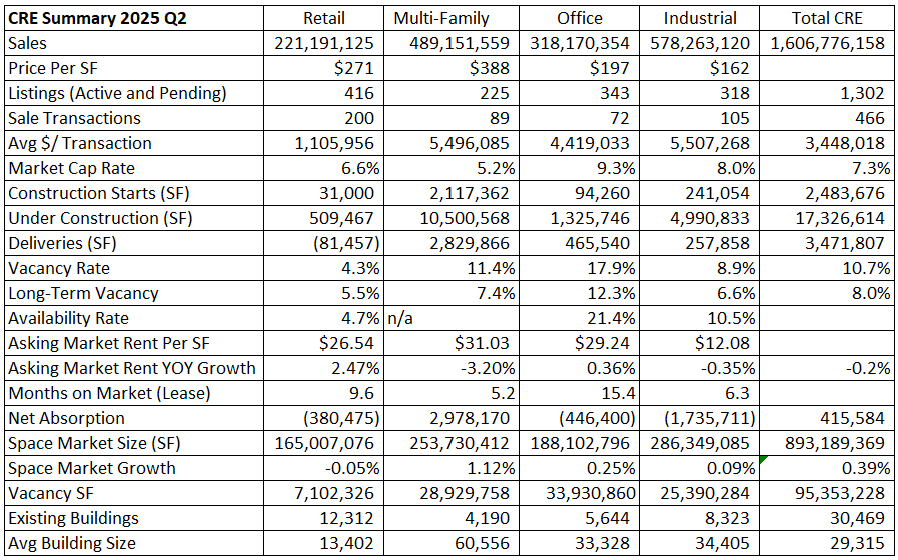
Supply
There are 1,229 active listings across the four major property types and 73 currently pending. New construction pipelines have contracted from their all-time highs, but there is still over 17M sf under construction. During Q2 2025, developers delivered 3.471M sf to the Denver MSA. Predominantly, the growth has been in multi-family with a pipeline of 10.5M sf under construction. The next highest pipeline under construction is industrial with 4.9M sf. It is worth noting that the Denver MSA has 30,469 buildings totaling 893M sf of space. Therefore, the overall CRE market expanded by 0.39% in Q2 2025.
Demand
Demand for commercial real estate is created by population growth and job growth. When our population is growing, there is an increased demand for housing and shopping. When jobs are created, there is more demand for industrial, office, and retail. With that said, office demand has changed a lot since the pandemic, as many employees were working from home. Many companies are bringing their employees back into the office, which will hopefully pick up the office demand. With that said, Kastle Systems key card swipe data is still showing 50-60% of people entering office buildings compared to before the pandemic.
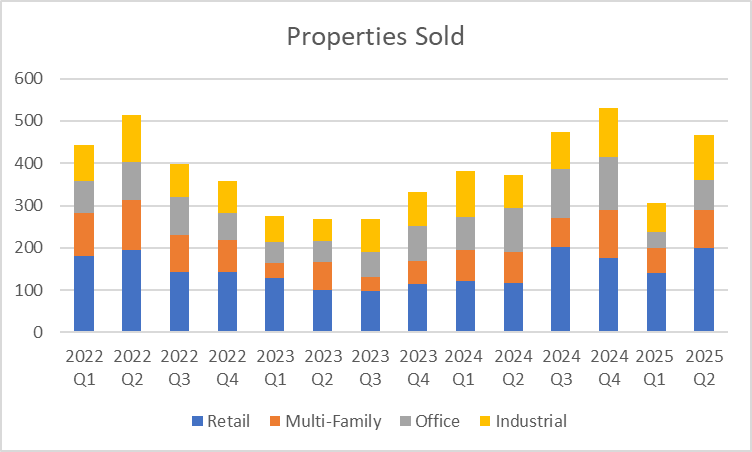
There were 466 closed sales in Q2 2025, which is an increase from 373 closed sales in Q2 2024. Both the sales and sales volume have increased. The total dollar volume for retail, multi-family, office, and industrial was $1.6B in Q2 2025 compared to $1.33B in Q2 2024.
Another gauge for demand is net absorption. Absorption is a gauge of the space tenants need to live or operate their businesses. In Q2 2025, Denver tenants gave back 2,562,586 sf across retail, office, and industrial properties. We have not seen negative absorption of this scale since the pandemic. The only property type to post a positive absorption was multi-family with 2.8M sf.
New Construction
Developers started construction on 2.48M sf during Q2 2025. This is nearly 2.5 times about the amount of construction starts when compared to Q2 2024. With that said, the construction pipeline was 17.36M sf in Q2 2025 compared to 23.9M sf Q2 2024. The total under construction has been slowing since multi-family peaked at 31,694 units during Q1 2023.
During Q2 2025, Retail started 31,000 sf, multi-family started 2.1M sf, office started 94,260 sf, and industrial started 241,054 sf.
Developers delivered 3.471 Msf of commercial space to the market during Q2 2025.
Next, let’s look at vacancy rates to see how much space is not occupied.
Vacancy Rates
A vacancy rate is a metric comparing the amount of unoccupied sf to the total sf of all the buildings in a market. Denver vacancy has climbed to 95.4M sf of Commercial Real Estate in the MSA. Although this sounds like a lot, Denver has 893M sf of commercial buildings. Therefore, our commercial vacancy rate is 10.7%. As you can see in the chart below, Office historically has a higher vacancy rate than all the other property types.
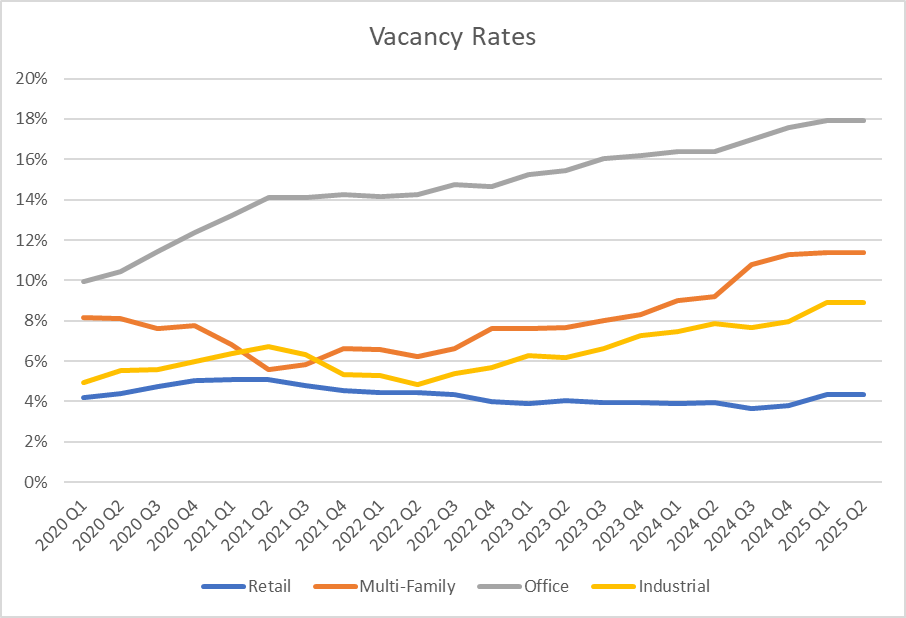
If we are to understand commercial vacancy rates, we need to compare the current vacancy rates compared to the long-term vacancy rates. Multi-family, office, and industrial all have higher vacancy rates when compared to their long-term average, which will limit rent growth. Retail is the only property type to have a vacancy rate below the long-term average. This is because retail has not been delivering much new product to the market.
Let's transition into rent growth.
Rent Growth
The higher vacancies has translated into lower rent growth. Rent growth could be lumped into demand but it is interesting enough to separate into a new paragraph. Retail properties posted the highest rent growth at 2.47%. Office had the next highest rent growth at 0.3%. Multi-family rents came down by (3.2%), and industrial rents compressed by (0.35%). Mutli-family is contracting because of all the new construction. In addition, to rent compression, many buildings are offering 10-13 weeks of free rent with a one year lease.
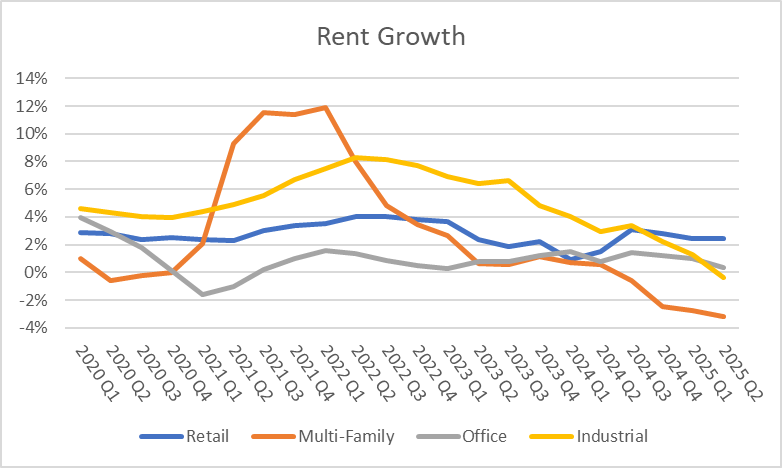
Final Thoughts
In Summary, supply, demand, new construction, vacancy rates, and rent growth are all good key performance indicators for the commercial real estate market in Denver. We have a decent supply of properties for sale. Demand for properties, as measured by sales volume, has increased significantly during Q2, but the higher interest rates are putting pressures on cap rates to rise. Though the transaction volume of smaller properties has picked up. Developers are hard at work building multi-family and industrial properties, with total construction growing. Vacancy rates are different among the different commercial property types. We expect office vacancies to stay higher for the foreseeable future. We also expect vacancy rates to climb with more multi-family units being delivered. Lastly, rent growth is stalling or negative and none of the property types are outpacing the current inflation rate.
Link to all of the presentations for each property type: